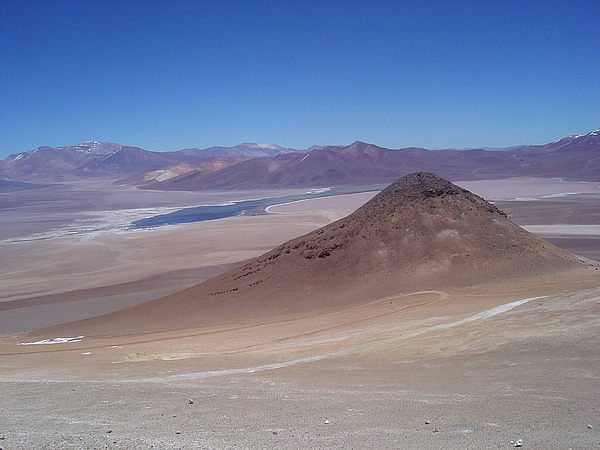Maricunga belt, Chile
The hypogene mineralization of the Dorado Oeste zone comprises a continuous spectrum from porphyry to intermediate/high-sulfidation epithermal mineral assemblages. The hydrothermal ore sequence, from early to latest, is: magnetite-hematite-pyrite, molybdenite, bornite-chalcopyrite-pyrite, pyrite-enargite to tennantite-tetrahedrite, covellite, gold. Gold occurs rarely in µm-large aggregates in quartz and associated with pyrite, enargite and covellite. Most gold is in the sub-µm size range. A remarkable feature of the hydrothermal system is the abundance of late anhydrite (10 wt% of the rock on average, partly weathered to gypsum) over 500 m drill core depth, which occurs together with abundant alunite. The presence of deep anhydrite vein infill indicates descending acid-sulfate water from shallow steam condensation.
The hydrothermal system is chemically characterized by a relatively narrow spectrum of elements enriched compared to bulk continental crust, i.e. Au-Re-Te (400-600 x), and As-Mo-S (100-200 x). Copper and Sb are enriched by a factor of 10 and 30, respectively. The arsenic budget is controlled by enargite and fahlore, although pyrite has a constant As abundance of around 1100 ppm. Arsenic, Sb and Hg correlate well (fahlore control), while Au has no correlation with any other element. This suggests that gold fixation is not controlled by any specific mineral, and that gold occurs as native gold. The gold content of pyrite, enargite and fahlore is below the analytical detection limit of the electron microprobe, i.e. <40 ppm Au, which excludes the sulfide minerals as major gold carriers.
Eight Mo-rich bulk rock samples define a Re-Os isochron age of 11.0 ±0.2 Ma (2 sigma) with an initial 187Os/188Os ratio of 0.7 ±0.2. Three Ar-Ar age data on deep potassic alteration and on alunite-altered rock are 11.39 ± 0.48 Ma (K-feldspar), and 11.24 ± 0.70 Ma (alunite) and 11.10 ± 0.32 Ma (alunite). These ages overlap within error and define a combined age of 11.20 ± 0.25 Ma (2 sigma) for the hydrothermal system.


